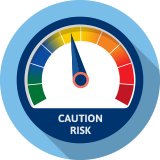June 12, 2018
L&S Risk Pulse™ Score

Caution
Long-term macroeconomic conditions are strong, but at least several core economic indicators show weakness with noteworthy but outlying risk that requires monitoring. Valuations are approaching high for a majority of stocks.
L&S Risk Pulse™ Insights – “Climbing the Proverbial Wall of Worry”
General Comments
The first quarter of most years since the end of the Great Recession have shown weak economic growth, and 2018 seems to have followed that pattern to the letter. The pick-up in growth that followed the weaker first quarters in previous years also seems to be repeating this year.
Many of the positives that were prevalent in the fourth quarter of 2017 have returned. Economic growth is no longer slowing, and looks to be re-accelerating as this quarter unfolds. Corporate earnings remain quite positive, due in part to the tax cuts passed at the end of 2017, but also because of solid organic growth. Valuations are not as stretched as they were in January. Home prices have continued to accelerate. Consumer confidence remains high, as does small business confidence. Personal income and personal spending are both higher, adding to the notion that the consumer remains in very good shape. The unemployment rate is at multi-decade lows, and the number of new jobs was again above expectations. Domestic stock markets posted solid gains in May, although most indices remain well below the January highs.
We would expect more companies to increase their capital spending plans as economic growth continues. New initiatives in the tax plan permit companies to immediately write off capital spending, even as the benefits accrue for many years in the future. While the initial data does not suggest significant tax savings have gone toward capital spending, we would expect that share to increase as companies have the time to make and execute plans. This should help propel the market for several more quarters.
To be fair, many of the non-economic concerns that were raised in the first calendar quarter have not gone away. Despite objections from economists and allies, the President has insisted on proceeding with tariffs on steel and aluminum. Trade partners have promise retaliation. News about negotiations with the Chinese and with Mexico and Canada seem to flow hot and cold, and the market has shown some ability to ignore the noise. This is a good thing since we do not need stock prices up and down by hundreds of points every time the temperature changes. Still, the trend has not been all that positive, and we do worry that a trade war is the kind of policy mistake that could put an end to our long-running expansion.
As economic growth has reaccelerated, the prospects that the Fed will delay its intent to raise interest rates has faded. The Fed will almost certainly raise interest rates when they meet on June 13th. The Fed virtually guaranteed three interest rate hikes this year, and there is no reason to doubt their intentions. As the Fed continues to push short-term rates higher, the shape of the yield curve has flattened. We have reported that when the Fed raises interest rates too aggressively we run the risk of a policy mistake that has historically been a harbinger of a coming recession. We do not see the Fed’s actions as having created a policy mistake, but the direction they are moving suggests we must be vigilant.
Historically, the party in power loses seats at the mid-term election. With strong economic growth and solid employment gains, it may be possible for Republicans to limit their losses, and polls are currently confirming the potential for that outcome. Still, it is likely that Congress will be less business-friendly after the election than it has been.
An old worry has also reasserted itself lately. Growth in Europe has slowed, and the Italians recently formed a government with two very populist parties in charge. The market reignited the worry that the European Union (EU) would fall apart. The Italian government has backed away from expressly suggesting it wants to leave the EU, but we all know how unpredictable populist governments can be. Markets have settled down, but Italian interest rates temporarily spiked, and that is not the kind of action that builds confidence.
Conclusion
Markets seem willing to climb the proverbial wall of worry. Despite known concerns, the market seems to be able to ignore much of the negative news and work its way higher. Good corporate earnings are once again being well-received by the market, and price action in May was much more positive. While many indices have a long way to go to make new all-time highs, some parts of the market, especially small capitalization stocks, are already at new highs. European problems have dissipated temporarily, but concerns will remain elevated, and that may limit significant gains in international markets in the short run. Our best indicators suggest there is no recession on the horizon for the remainder of 2018 and into 2019, although we must remember that the normal mid-term election pattern suggests some additional market weakness prior to the election. At this point we are more likely to suggest that any additional market weakness may be a buying opportunity.
